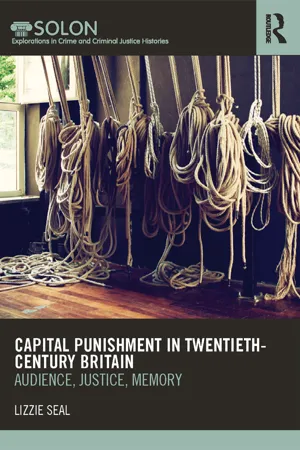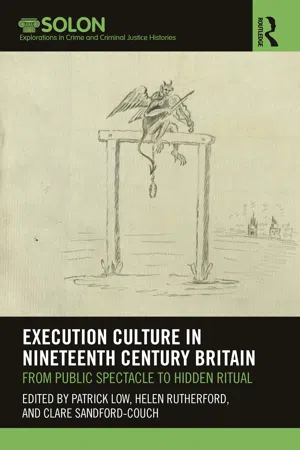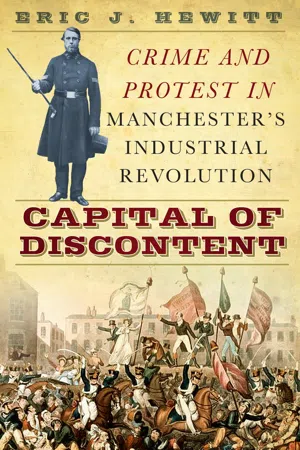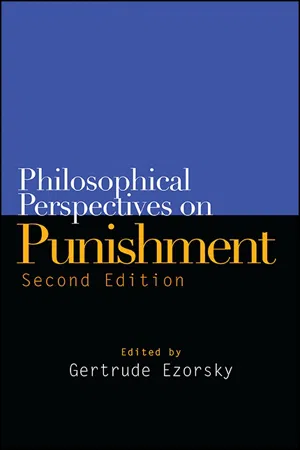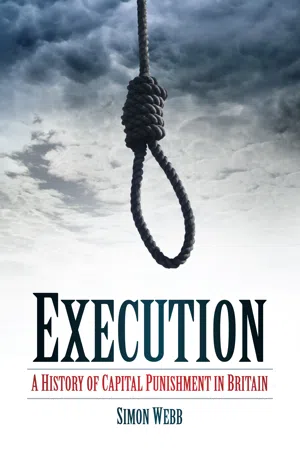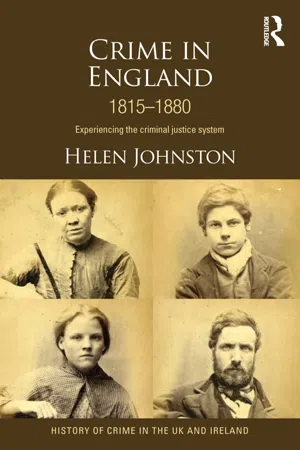Capital Punishment in UK
Capital punishment in the UK has a long history, with various methods such as hanging, beheading, and later, the use of the guillotine. The death penalty was abolished for murder in 1965 and completely abolished in 1998. The UK's approach to capital punishment has evolved over time, reflecting changing societal attitudes and a growing emphasis on human rights.
8 Key excerpts on "Capital Punishment in UK"
- eBook - ePub
Most Deserving of Death?
An Analysis of the Supreme Court's Death Penalty Jurisprudence
- Kenneth Williams(Author)
- 2016(Publication Date)
- Routledge(Publisher)
...Chapter 1 History of Capital Punishment in the United States History of Capital Punishment Societies have used death to punish criminals for their transgressions since the fifth century BC. The first formal death penalty laws were established in the eighteenth century BC, when the Code of King Hammurabi of Babylon codified the death penalty for 25 different crimes. Murder was the primary offense that subjected an individual to the death penalty but there were many others. Individuals were also sentenced to death for marrying a Jew, not confessing to a crime, treason, uttering blasphemy, cursing a parent, publishing libels and insulting songs, and making disturbances in the city at night. Executions were carried out by burning at the stake, hanging, beheading, boiling in oil, crucifying, drawing, quartering and disemboweling, and decapitation. English common law recognized eight capital crimes: treason, petty treason (the killing of a husband by a wife), murder, larceny, robbery, burglary, rape, and arson. However, the number of capital crimes in Britain increased dramatically between the seventeenth and nineteenth centuries. By 1820, there were more than 200 capital crimes in Britain. In addition to the common law capital crimes, individuals could also be executed for many property crimes, such as theft of a pocket handkerchief, and forgery. The late nineteenth century saw a marked decline in crimes punishable by death, due largely to the refusal of British jurors to convict if the offense was not serious. After 1863, murder was the primary offense for which people were executed until England abolished the death penalty in 1965. English settlers brought the common law, including the death penalty, with them when they came to America. The first recorded American execution occurred in 1608. Captain George Kendall was executed in the Jamestown colony of Virginia for being a spy for Spain. Death penalty laws varied considerably among the colonies...
- eBook - ePub
Capital Punishment in Twentieth-Century Britain
Audience, Justice, Memory
- Lizzie Seal(Author)
- 2014(Publication Date)
- Routledge(Publisher)
...Its continuing de-ritualisation and the restriction of its use indicated unease with the practice at the political level. The reinvigoration of the abolitionist movement in the mid-twentieth century reflected growing uncertainty. Intensifying press and public contestation of particular high-profile capital cases, as well as heightened attention to capital punishment as an issue, also demonstrated a deepening ambivalence in the wider culture. At stake were understandings of Britain as a modern, civilised society and notions of what it meant to be a citizen in that society. In 1957, legal scholar, HLA Hart, compared capital punishment in the United States and England, arguing ‘English people have probably been more disturbed and more divided by the use of the death penalty for murder than any people who still retain it as a form of punishment for that offense’. 41 The rest of the chapter provides contextual background in relation to the operation of capital punishment in Britain since the late nineteenth century. The late nineteenth century Following the publication of the report of the Royal Commission on Capital Punishment in 1866, hanging ceased to be a fully public event in 1868 and was from then on to take place within prison grounds...
- eBook - ePub
Human Rights
An Introduction
- Darren O'Byrne(Author)
- 2014(Publication Date)
- Routledge(Publisher)
...There is no space, therefore, to provide a thorough history of its use here. I shall instead focus on certain key trends and dates in a very summary fashion, drawing data liberally from Peter Hodgkinson and Andrew Rutherford's excellent global survey, Capital Punishment: Global Issues and Prospects. Students wishing to learn more about the death penalty in the various regions of the world are strongly advised to consult this collection. The death penalty in Europe In England and Wales, executions had formed part of the ‘bloody code’ which for a long time defined the legal system. For example, between 1770 and 1830, some 36,566 death sentences were passed, resulting in between 6,322 and 7,713 executions. 3 However, after 1861, these numbers declined, and murder and treason were, in practice, the only remaining capital offences. The Murder (Abolition of the Death Penalty) Act of 1965 officially abolished it for all but the ‘exceptional crimes’ of piracy and treason (following the UK's last execution in 1964), and this was confirmed by a free vote in 1969. Total abolition for all crimes was finally agreed in 1998. Indeed, the abolitionist trend, reflecting an inherent incompatibility between the death penalty and some notion of civilisation, is most clearly apparent in the case of Western Europe. Although some countries had already led the way with abolition for ordinary crimes (Portugal in 1867; the Netherlands in 1870; Sweden in 1921; Denmark in 1930), it was the experience of ‘total war’ which encouraged others to do the same. Italy started the trend, abolishing it for ordinary crimes in 1947, although, like most other countries, it retained the punishment for certain special crimes. West Germany abolished the death penalty for all crimes after its last execution in 1949 (total abolition extended to all Germany after reunification). The Netherlands had done away with the punishment for ordinary crimes as long ago as 1870, and for all crimes in 1982...
- eBook - ePub
Execution Culture in Nineteenth Century Britain
From Public Spectacle to Hidden Ritual
- Patrick Low, Helen Rutherford, Clare Sandford-Couch(Authors)
- 2020(Publication Date)
- Routledge(Publisher)
...As residents of his ‘future age’, we should indeed question what could be learned from study and reflection on the execution culture of the past. A focus on execution culture in the long nineteenth century in Britain contributes to an understanding of the death penalty and its symbolism and power during this period, but it is not a study in isolation; it has important resonance beyond a historical interest. Although this collection has an expressly British focus, it would be remiss not to acknowledge the continued utilization of capital punishment across the world. 2018 saw a ten-year overall record decline in executions; however, the imposition of the death sentence has risen in numerous countries. 75 Furthermore, where once the prison walls were a barrier to a prurient public, the internet has opened new avenues to give access to witnesses to state-sanctioned and other lethal violence. In the nineteenth century, a turnout of tens of thousands to a London hanging was met with almost universal reproach, but today a single online video of an execution may achieve hits in the millions: an appetite to witness execution has not disappeared. 76 It is important to understand the motivations and historical context for these phenomena in order to shed light on our present condition. This collection offers a much-needed study of a punishment that must not be viewed as a barbaric remnant of a distant past. It is a present concern. Notes 1 Tyne and Wear Archives Museum, Newcastle upon Tyne (‘TWAM’), Diaries of Richard Lowry, 23 August 1844, DF.LOW/1/11, pp. 298–301. 2 Capital punishment was to continue in Britain until 1965 (Murder (Abolition of Death Penalty) Act 1965)...
- eBook - ePub
Capital of Discontent
Protest and Crime in Manchester's Industrial Revolution
- Eric J. Hewitt(Author)
- 2014(Publication Date)
- The History Press(Publisher)
...6 PUNISHMENTS Early nineteenth-century England seemed to survive without an effective police force, through an over-reliance on its harsh criminal code and penal policy. In 1820, for example, there were 288 capital offences on the statute book. The threat of the death penalty was considered an effective deterrent and a means by which the political elite maintained power and control over the working class. It was Robert Peel, as Home Secretary, who in the 1820s stated the government’s intention to carry out a reform of the criminal law. He appointed a parliamentary committee, headed by James Mackintosh, to overhaul the existing system. The committee’s proposals included repeal or codification of criminal law statutes and the abolition of capital punishment for all but murder and high treason. Peel’s reform programme had less to do with mercy or humanitarianism, as some have claimed, and more to do with efficiency and the need for clarity. According to Douglas Hurd, ‘Quite simply, Peel found the criminal law to be in a muddle and, as a born administrator, he found the task [of reform] appealing to his practical mind.’ 1 The task he had set himself would have been lost, however, unless something was done about the application and enforcement of the law. The reform of policing, therefore, became a logical follow-on from the reform of the criminal law, as we shall see in Chapter 7. Through the course of the century, there was a discernible shift in government policy with regard to the punishment of those in breach of the criminal law. In the early years, punishment was often a public spectacle enjoyed by the masses. Execution by hanging took place outside of prison walls, usually on elevated scaffolding for all to see, and often accompanied by all manner of entertainments, including food stalls, jugglers and fortune-tellers...
- Gertrude Ezorsky, Gertrude Ezorsky(Authors)
- 2015(Publication Date)
- SUNY Press(Publisher)
...It is true, as has often been pointed out in reply to this argument, that capital punishment as applied in Great Britain falls very far short of a threat of instant and certain death to every murderer. This is clearly shown by the figures in Tables 1 and 2 of Appendix 3. During the 50 years 1900–1949, 7,454 murders were known to the police in England and Wales. In 1,674 cases the suspect committed suicide. During the same period 4,173 persons were arrested on a charge of murder and 3,129 were committed for trial at assizes. 10 Of those committed for trial 658 were acquitted or not tried, 428 were found insane on arraignment and 798 were found guilty but insane. Of those convicted of murder 35 were sentenced to penal serviture for life or detention during H. M. pleasure and 1,210 were sentenced to death. Of those sentenced to death 23 had their conviction quashed on appeal, 47 were certified insane and 506 were reprieved. There remain 632 (621 men and 11 women) who were executed for murder. There was therefore only one execution for every 12 murders known to the police. In Scotland the proportion was even lower. In that country during the same period 612 murders were known to the police, 59 persons were convicted of murder and sentenced to death and 23 (22 men and 1 woman) were executed. There was therefore less than one execution to every 25 murders known to the police. But these odds against being hanged for murder are probably realised only vaguely, if at all, by would-be murderers. Those who, like Stephen, are convinced that the fear of death cannot fail to have a more potent effect on most men and women than the fear of any other punishment are not likely to be shaken in that conviction by these figures. 59. Capital punishment has obviously failed as a deterrent when a murder is committed. We can number its failures. But we cannot number its successes. No one can ever know how many people have refrained from murder because of the fear of being hanged...
- eBook - ePub
Execution
A History of Capital Punishment in Britain
- Simon Webb(Author)
- 2011(Publication Date)
- The History Press(Publisher)
...Rule 8 went on to specify that: It will be considered objectionable conduct for any person to make an application to a sheriff or under-sheriff for employment in connection with an execution, and such conduct may involve removal of such person’s name from the list. Four years after the end of the Second World War, a Royal Commission was set up to consider whether the circumstances under which capital punishment for murder was applied should be changed. Many witnesses were summoned to give evidence to the commission, including the Lord Chief Justice and the Archbishop of Canterbury. The actual terms of reference for the commission were as follows: To report and consider whether liability under the criminal law in Great Britain to suffer capital punishment should be limited or modified, and if so, to what extent and by what means, for how long, and under what conditions persons who would otherwise be liable to capital punishment should be detained, and what changes in the existing law and the prison system would be required; and to inquire into and take account of the position in those countries whose experience and practice might throw light upon these questions. The Home Office submitted a memorandum to the Royal Commission which gave some details of the days leading up to the execution. It is worth quoting in full, as it gives a fascinating insight into the mundane details of capital punishment as practiced in the mid-twentieth century: Immediately a prisoner sentenced to death returns from court, he is placed in a cell for condemned prisoners and is watched night and day by two officers. Amenities such as cards, chess, dominoes etc., are provided in the cell and the officers are encouraged to – and in fact invariably do – join the prisoner in these games. Newspapers and books are also provided. Food is supplied from the main prison kitchen, the prisoner being placed on hospital diet, with such additions as the medical officer considers advisable...
- eBook - ePub
Crime in England 1815-1880
Experiencing the criminal justice system
- Helen Johnston(Author)
- 2015(Publication Date)
- Routledge(Publisher)
...There had been a great deal of concern about the behaviour of the crowd at executions and whether or not such events conveyed the correct message of punishment. Social commentators feared that the gruesome displays of violence only hardened the brutal crowd, who thought nothing of the suffering of those on the gallows and neither sympathised with them nor feared a similar fate. The deterrent effect of punishment was called into question, as was the rowdy and unseemly behaviour of the crowd, which was seen as particularly distasteful (Linebaugh, 1975 ; Spierenburg, 1984 ; Laqueur, 1989 ; McGowen, 1987 ; Pratt, 2002 ; Devereaux, 2009). On the statute books under the system known as the ‘Bloody Code’, there were a large number of capital offences, but in reality it was not quite as ‘bloody’ as the 250 or 260 crimes suggest; legislation was often minutely defined by a separate Act of Parliament and quite different to the criminal law in the early nineteenth century, when offences were consolidated into groups. That said, a large number of people were processed in the criminal justice system for offences that could warrant a capital sentence; while large numbers were sentenced to death, they were not necessarily all executed (Hay, 1975). Gatrell (1994) argues that, by the early nineteenth century, the increased numbers of prosecutions for capital crimes, resulting from both the larger population and more effective methods, meant that the number of people actually executed had to be curtailed. There were various ways during the criminal justice process by which a criminal or condemned person might be able to escape the noose, and many were pardoned or reprieved...

